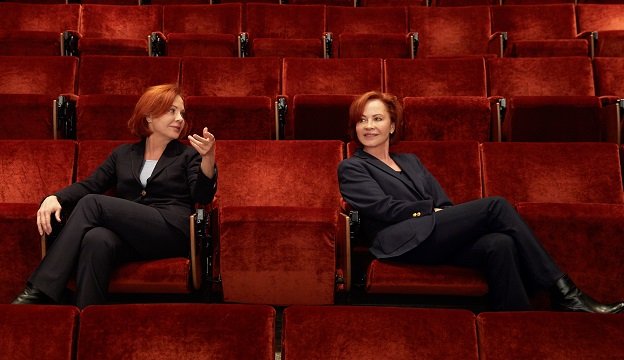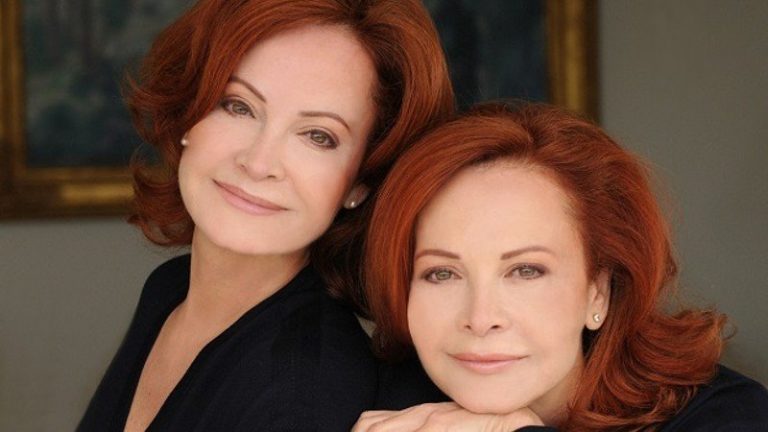Turkish pianists Güher and Süher Pekinel have been awarded the prestigious Lifetime Achievement Award of ICMA. This award is highly justified for the almost fifty years that Pekinels have graced the international stage, starting from the 1980’s when only a handful of Turkish musicians could find their way into the classical music scene. Their unique musicality, stage presence and deep artistic knowledge have paved the way to this very important award. The Pekinels have devoted most of their time, in recent years, to educational projects and preparing talented young musicians from all over Turkey to the concert stage and are therefore one of the most hard-working musical ambassadors present. They have been interviewed by Feyzi Ercin, from the Turkish Jury member Andante.
– You are a duo with countless achievements and numerous awards. What does an award signify to an artist, and what does this one specifically mean to you?
– The ICMA Award has once again proven to be a significant source of motivation for us. Foremost among its merits is the recognition of our endeavors by fellow musicians, serving as an indicator of our resonance within the artistic realm. Furthermore, the distinguished nature of the award, adjudicated by a jury drawn from the spectrum of European music publications and broadcasters, makes it even more meaningful. Indeed, this accolade perennially serves as a beacon, igniting the drive for further refinement through self-reflection.
– Your most unique attribute is to play without eye contact, on parallel but not side-by-side pianos. How and when did this idea flourish in you? Since adopting this approach, what accomplishments have you achieved as musicians? Has your style, sound, or response to music changed?
– The pianos we were going to play on our tours were not entirely satisfying us. The absence of the eye contact contributes to establishing a highly creative sense of distance. We become receptive to risks through our concentrated feeling. When the pianos are placed vis-à-vis and one piano’s cover is removed, the sound of the second piano reaches the hall only with a loss of 65% of its original purity. Additionally, the pedals often appear blurred, causing the tone quality to lose much of its character. Furthermore, we continually refine our conception of symphonic sound. For us, this placement is the most logical and natural. We don’t need to see each other anymore. We feel stronger nonetheless without the eye-contact. Our ears serve as our eyes, and our eyes as our ears. Our musical path is determined by two aspects: Firstly, there’s the flowing breath which we seek to experience deeper and longer. Secondly, and equally crucial, is risk. The more controlled we are, the more we want to be free. In this state of freedom, synonymous with total control (one impossible without the other), we get to experience absolute freedom in the face of maximum risk, which we can define as ‘Realization of Momentum’.
– How are you working together on one piece? And what is the essence of working together?
– Firstly, we individually study both parts of a piece to gain more flexibility in our vision. However, during the joint interpretation, the musical core and the idea of the work is the only significant essence, which we strive to capture together. Consequently, it is the combination of our solo work and the culmination of our teamwork that contribute to creating our interpretation.
– Would this harmony between you exist even if you were not twins?
– This is pure speculation, but I think that we would have found synchrony, perhaps not as distinct. We communicate almost telepathically. We focus on every detail, yet every concert is a surprise. Our intuition helps us transcribe surprises into music. One of the most important reasons why we sit in this position is that the first Piano relates through his breathing of back of the body to the second piano. As soloists we need our freedom. We embrace higher risk to heighten the momentum, allowing us to live and let live more intensely.
– Are such experiments in relation to music or is it the result of knowledge and experiences throughout the years?
– We have come to the conclusion, that this new positioning allows us to form and experience the breath and the rhythm of the music more individually. It is based on the accumulation of a long search and experience in order to reach perfection in the musical interpretation at all levels.
– In one of your interviews discussing music, you were talking about hearing colors and seeing sounds. What exactly were you describing?
– It’s about recognizing the great potential hidden within the human soul, a realization achievable only through personal development. Tone is a sound that encapsulates each pianist’s unique palette of colors. When listening to an instrument, each listener will perceive the tones of that artist in their own unique way, as a combination of different hues. As interpreters, we nurture the colors of music within us by hearing them and seeing the sounds. Beethoven, as his senses waned with time, abstractly brought to life the colors and sounds he internally created, perceiving them in a polyphonic manner, and somewhat visually transcribing them onto paper. Rembrandt’s masterful perception of light in his works, created under extremely dim candlelight, serves as another testament. His creativity was so immense that even in candlelight, he ingeniously produced paintings with his signature light. Goethe’s musings referencing Scriabin’s color scale, along with Delaunay and Kandinsky’s color theories related to music, are all examples of this fusion. Regardless of the artistic field, it’s impossible to create your own art without being influenced by the distinctive features of other artworks.

– Being in the moment is vital to create, not just play the notes; you have to live it. How did you reach this point? What lies behind this achievement?
– From very early on, we began to delve deeply into various traditional piano schools, particularly the Russian School, from Sergei Rachmaninov, Josef Lhévinne, to, Josef Hofmann , Vladimir Horowitz, Emile Gilels, and Heinrich Neuhaus. We also studied and analysed the piano school and interpretations of Wilhelm Backhaus, Theodor Leschetizky, and Artur Schnabel. Besides their different piano sounds and techniques , their intellect and soul were essential for us. To this day, nothing has changed, and with the same joy, we continuously seek new visions to deepen the inner language and dimensions of a composition.
– How does the moment relate to the long breath in a work from the beginning to the end? What are you aiming for with it?
– Our characters differ from each other, and how we start to work on a piece can be contradictory from the beginning.
We like to compare it to painting. Much develops already in the first sequence, and afterwards, spontaneous discoveries come through the genuine encounter with the material. Our tonalities are also very different from each other, which is a beneficial feature since the music thrives within the colors and tone presentations of each pianist. This led us to position our pianos back to back. This special arrangement allows us to shape and experience the breath and rhythm of the music more individually but also together, creating more colors, layers and space. And of course, everything has to unfold in a long breath, without interrupting the form.
– You are an all-round artist with an affinity towards painting, especially Kandinsky, who is arguably the quintessential painter. What does painting mean to you?
– To hear colors also entails seeing sounds. During our high school years, we were greatly influenced by two books by Kandinsky, ‘Punkt und Linie zu Fläche’ and ‘Das Geistige in der Kunst.’ The turning point in painting that he initiated around 1911 in Germany brought forth significant movements such as ‘Der Blaue Reiter’ and ‘Bauhaus.’ In France, at that time, various innovative movements in music, painting, and literature were preparing the groundwork for intertwined new formations. Although art history perhaps experienced its most rapid change during the Renaissance period, change has always been there up to the present day. What matters is how deeply an artist follows the movements around them, how they are influenced by them, and how they convey them. We also attended seminars in Munich on Kandinsky’s ‘Der Blaue Reiter’ movement, and these seminars were very helpful to us at the time when we were recording Stravinsky’s Sacre du Printemps for Deutsche Grammophon. We see each other through listening and shape the colors of that sound within us according to our own perspectives. In short, our ears become our eyes, and our eyes become our ears.
– Did you experience another kind of freedom, perhaps while playing with Jacques Loussier?
– We are very familiar with Bach since our childhood. He created timeless structures. He is a composer who can be easily transformed due to the mathematical transparency of his works. This is why he has always been so popular among jazz musicians. The rearrangement of the architecture of Bach’s works allows capturing the ‘swing’ in jazz. It is not easy to bring classical music and jazz together. Delicate structural differences emerge here. A harmony should be created between two music cultures and expressions. It is very rare for musicians to achieve this multi-dimensional harmony. Jacques Loussier, with his genuine adaptations, is among such musicians. Classical music expands, enriches, and finds freedom through jazz, while jazz discovers another depth in the tradition of classical music. Curiosity grows, and that is the essence of this alliance. The distance between classical and jazz listeners shrinks, and both types of music melt together without reducing their quality. We experienced a lot through this involvement.
– Serkin, Arrau, and Fleisher: they are part of a romantic piano tradition that no longer prevails and hardly exists. Would you say that the art of those masters will never be forgotten and continue to inspire young musicians?
– We can say that we are greatly influenced by all three of them. Each of them is a school in their own right due to their unique character, musical language, piano technique, refined interpretation, and of course, their distinctive tones. Thanks to YouTube videos, a product of modern technology, future generations will also listen to them, appreciate their values, and reflect them in their own musical interpretations.
– Your efforts directed towards young musicians are also earning you praise. Why is it crucial to support emerging musicians?
– While studying in Germany (under August Leopolder at the Frankfurt University of Music – student of Leschetizk) and in the USA (under Rudolf Serkin and Leon Fleisher at the Curtis Institute of Music, and Adele Marcus -student of Josef Lhevinne – at The Juilliard School and private with Claudio Arrau ), we received significant support from prominent musicians, managers, and record companies. Mentorship from respected conductors and musicians such as Maestro Karajan, Zubin Mehta, Leonard Bernstein, Sir Colin Davis, Sir Neville Marriner, Marek Janovsky, and Jack Loussier greatly enriched our musical lives. We now utilize the opportunities and support provided to us at the time to discover exceptional talents through various projects, nurturing them towards becoming internationally recognized figures in the world of music. As they will play a crucial role in shaping the future of music by enriching society culturally, it is imperative for them to be well-equipped in every aspect. To provide them with this preparation, we mobilize all kinds of time, resources, and relationships at our disposal. In addition to guiding them towards renowned mentors and schools, we ensure they have access to the best instruments for their studies. In order to continue benefiting from the system we have established, the talents selected by us are obliged to participate in important international competitions to prove themselves. This exposure ensures that their names are heard on various platforms, leading to significant opportunities that will determine their futures. We established three music education systems, which are: DSGM (Young Musicians on World Stages), TEVITÖL (Highschool for Extraordinary Talented Students) and ORFF ANATOLIA SCHOOLS SYSTEM.
– You are still at the peak despite reducing the number of concerts in recent years. We understand how difficult it is to maintain such a position. How do you manage it?
– It was a deliberate choice on our part. Getting lost in the routine of concerts can consume an artist. We have witnessed such cases with some important artists we know. The key is to recognize your boundaries while pushing your limits. This guides you back to finding balance within your being. Our current situation is ideal for us: working with prestigious companies and orchestras around the world, performing fewer but higher-quality concerts…
– Reflecting on your history through the lens of this Lifetime Achievement Award, what would you consider your greatest accomplishments in life, those that bring you immense satisfaction?
– First and foremost, the opportunity to collaborate with the world’s top musicians and orchestras. In addition, our released CDs, videos, and all reviews. And of course, the three educational systems to which we have devoted our years, and the first prizes awarded to young musicians trained within these systems on the international stage.











